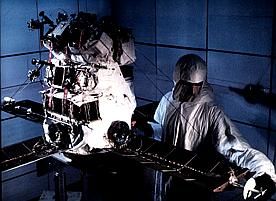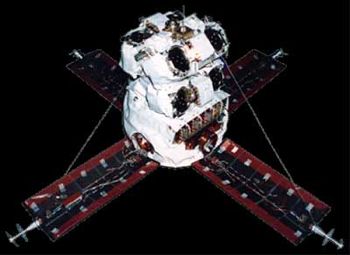
Home - Search - Browse - Alphabetic Index: 0- 1- 2- 3- 4- 5- 6- 7- 8- 9
A- B- C- D- E- F- G- H- I- J- K- L- M- N- O- P- Q- R- S- T- U- V- W- X- Y- Z
ALEXIS
 Alexis Credit: LANL |
AKA: Array of Low-Energy X-ray Imaging Sensors. Status: Operational 1993. First Launch: 1993-04-25. Last Launch: 1993-04-25. Number: 1 . Gross mass: 115 kg (253 lb). Height: 1.00 m (3.20 ft).
The mission was also intended to demonstrate the feasibility of quickly building low cost sensors for arms treaty verification. An anomaly caused one of the satellite's four solar panels to break away from the vehicle during launch, causing a temporary loss of the spacecraft. Ground controllers were eventually able to control the spacecraft and begin on-orbit operations.
The spacecraft's four deployed solar panels provided 50 watts average power and charged four NiCd batteries. The command computer used redundant 80C86 processors and had a mass memory of 100 Mbytes EDAC solid state storage. S-Band communications had a downlink rate of 750 kbps and an uplink rate of 9.6 kbps. The bus pointed the payload in the anti-sun direction and rotated at 2 rpm about that sun-line. Sun sensors and limb sensor provided attitude knowledge of 0.1 deg. Attitude was controlled using magnetic torque coils. The single ground station installed at LANL had a 2 m antenna.
The primary payload was an ultrasoft X-ray monitor which consisted of 6 compact normal-incidence telescopes tuned to narrow bands centered on 66, 71, and 93 eV.
As of 21 January 1997 ALEXIS continued to operate nominally, sending the results of EUV telescope observations on every pass. ALEXIS identified a number of transient outbursts in near real time and sometimes was able to supply such target opportunities to operators of the EUVE satellite which contained instruments that were sensitive on similar wavelengths. During occasional "hot times" when ALEXIS was illuminated by the sun during 100% of it's orbit, the telescopes ceased operations to avoid overheating the spacecraft (normally the spacecraft passed through the earth's shadow. ) This anomaly was probably caused by a tear in the thermal insulation, associated with the solar panel damage that occurred during launch. The spacecraft's cost was reported to be approximately $17 million.
More at: ALEXIS.
Family: Astronomy, Medium earth orbit, X-ray astronomy satellite. Country: USA. Launch Vehicles: Pegasus. Launch Sites: Point Arguello WADZ. Agency: AeroAstro. Bibliography: 2, 279, 6, 6335, 12037.
 | Alexis Credit: Manufacturer Image |
1993 April 25 - . 13:56 GMT - . Launch Site: Point Arguello. Launch Complex: Point Arguello WADZ. Launch Pad: Aircraft from Edwards.. Launch Platform: NB-52 008. Launch Vehicle: Pegasus.
- Alexis - . Payload: Alexis (P 89-1B). Mass: 115 kg (253 lb). Nation: USA. Agency: USAF STP. Class: Astronomy. Type: X-ray astronomy satellite. Spacecraft: Alexis. USAF Sat Cat: 22638 . COSPAR: 1993-026A. Apogee: 746 km (463 mi). Perigee: 741 km (460 mi). Inclination: 69.80 deg. Period: 99.70 min. Test of X-ray imaging sensors; solar array deployment malfunction. Spacecraft engaged in research and exploration of the upper atmosphere or outer space (US Cat B). Air dropped in Point Arguello WADZ..
Back to top of page
Home - Search - Browse - Alphabetic Index: 0- 1- 2- 3- 4- 5- 6- 7- 8- 9
A- B- C- D- E- F- G- H- I- J- K- L- M- N- O- P- Q- R- S- T- U- V- W- X- Y- Z
© 1997-2019 Mark Wade - Contact
© / Conditions for Use